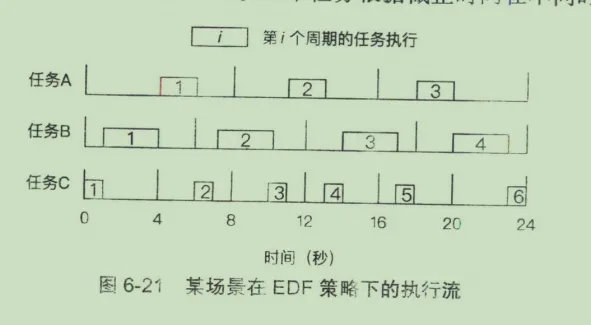目录
我们之前介绍了优先级调度算法和简单优先级调度算法,这两种调度算法都是基于优先级的值来调度的,也就是每个任务在创建的时候,会分配一个优先级,那么较高优先级始终比较低优先级优先调度。今天我们介绍rtems中另一种调度算法,EDF,最早截止事件调度算法
介绍EDF调度算法
对于最早截止时间调度算法而言,默认情况下会给任务分配一个截止事件,调度器根据每个任务的截止时间来确定优先级,它需要预设一个周期,当任务的实际运行时间越靠近周期设置时间,那么任务的优先级越高。这里优先级的动态调整通过的是timer来实现。
下面通过图示来介绍一下EDF调度算法的工作规则
现在加上,有任务A,B,C共三个任务,其中:
- A任务运行时间为2s,A任务的截止时间(周期)是8s
- B任务运行时间为3s,B任务的截止时间(周期)是6s
- C任务运行时间为1s,C任务的截止时间(周期)是4S
根据上面的信息,实际EDF的执行流程会如下表现

光看图片可能不好理解,如下解释一下就清楚了:
- 根据EDF调度的定义,从0时刻开始调度,那么C的优先级最高,因为C的截止时间最短
- 到第1s的时候,C任务完成执行,但是还没有到周期,此时B任务截止时间是5,A任务截止时间是7,此时B优先级高
- 到第4s的时候,B任务完成调度,此时C任务也到达周期,C任务的截止时间是4,A任务的截止时间是4,但是A先如的队列,默认执行A
- 到第6s的时候,A任务完成执行,此时B任务到达周期,B任务截止时间是6,C任务优先级最高,默认执行C
- 到第7s的时候,C任务完成,开始执行B任务
- 到第10s的时候,B任务完成,并且没到截止时间,此时A任务的截止时间是8s,C任务优先执行
- 第11s的时候,A任务得以执行,因为B和C都未到截止时间
- 以此类推。
根据上面的详细解释,我们知道了edf调度算法的执行逻辑,下面查看实现
预设周期
根据上面分析的,如果我们需要使用edf调度算法将任务运行,那么任务必须要有一个周期值设置,在rtems中,设置周期的方式如下
status = rtems_rate_monotonic_create( argument, &rmid ); status = rtems_rate_monotonic_period( rmid, Periods[ argument ] ); status = rtems_rate_monotonic_delete( rmid );
上面的意思非常容易理解,就是为edf调度器设置一个周期,其实现通过timer。
那其实际对timer的操作如下
_Watchdog_Initialize( &the_period->Timer, _Rate_monotonic_Timeout ); deadline = _Watchdog_Per_CPU_insert_ticks( &the_period->Timer, cpu_self, next_length );
值得注意的是,这里会提前设置周期的长度为 Periods的值,如下
the_period->next_length = length;
所以当timeout的时候,会再次重启timer。
_Rate_monotonic_Restart( the_period, owner, &lock_context );
或
_Rate_monotonic_Renew_deadline( the_period, &lock_context );
根据截止时间设置优先级
根据上面的介绍,我们知道了edf调度算法会通过截止时间来动态调整优先级,也知道了默认情况下我们会预先设置一个周期值,这个周期值就是rtems_rate_monotonic_period的第二个参数,接下来,我们需要明确edf算法如何根据截止时间来动态调整优先级
首先,我们关注_Rate_monotonic_Release_job函数,其实现如下
static void _Rate_monotonic_Release_job( Rate_monotonic_Control *the_period, Thread_Control *owner, rtems_interval next_length, ISR_lock_Context *lock_context ) { Per_CPU_Control *cpu_self; Thread_queue_Context queue_context; uint64_t deadline; cpu_self = _Thread_Dispatch_disable_critical( lock_context ); deadline = _Watchdog_Per_CPU_insert_ticks( &the_period->Timer, cpu_self, next_length ); _Scheduler_Release_job( owner, &the_period->Priority, deadline, &queue_context ); _Rate_monotonic_Release( the_period, lock_context ); _Thread_Priority_update( &queue_context ); _Thread_Dispatch_enable( cpu_self ); }
上述函数的步骤如下
- 为周期值开启一个定时器watchdog,返回定时器的时间period
- 根据定时器时间来确定deadline
- 根据deadline来调整scheduler edf的优先级Priority
- 在edf调度器中更新优先级的值
- 打开线程dispatch
我将关键点函数提取出来如下
rtems_rate_monotonic_period( rmid, Periods[ argument ] ); _Watchdog_Insert(header, the_watchdog, expire); deadline = _Watchdog_Per_CPU_insert_ticks(*) _Priority_Node_set_priority(*) _Thread_Priority_update( &queue_context ); _Thread_Dispatch_enable( cpu_self );
根据上面的代码流程,我们知道了,在edf调度算法中,一个周期Period内,优先级是根据watchdog的expire来动态调整,expire的值会换算成调度器的priority值,edf调度算法根据此值来动态调整任务的优先级
红黑树管理优先级
对于调度器的优先级管理,edf中使用的是红黑树,其主要函数如下
_Scheduler_EDF_Schedule, /* schedule entry point */ \ _Scheduler_EDF_Yield, /* yield entry point */ \ _Scheduler_EDF_Block, /* block entry point */ \ _Scheduler_EDF_Unblock, /* unblock entry point */ \ _Scheduler_EDF_Update_priority, /* update priority entry point */ \
下面我们逐个介绍调度器管理优先级的方式
执行调度
_Scheduler_EDF_Schedule的作用是将当前任务调度一次,此时需要获得优先级最高的任务,对于edf而言,默认expire值最小说明优先级越高,所以在红黑树中是获得最小的节点,在红黑树获得最小节点的方式是遍历根节点,找其左孩子
那么执行调度过程中,获得最高优先级任务的方式如下
RBTree_Node *_RBTree_Minimum( const RBTree_Control *tree ) { RBTree_Node *parent; RBTree_Node *node; parent = NULL; node = _RBTree_Root( tree ); while ( node != NULL ) { parent = node; node = _RBTree_Left( node ); } return parent; }
当找到优先级最高的任务之后,直接设置其标志位为true即可
_Scheduler_uniprocessor_Schedule _Thread_Dispatch_necessary = true;
让出任务
对于让出任务而言,我们需要做的是
- 将任务从红黑树中删除
- 根据新的优先级,将任务插入到红黑树中
- 执行调度
关于1,其实就是红黑树的删除操作,其代码如下
RTEMS_RB_REMOVE( RBTree_Control, the_rbtree, the_node );
关于红黑树的删除,可以查看文章<rb-tree实现-删除操作-原理>
关于2,其实就是红黑树的插入操作,其代码如下
static inline bool _RBTree_Insert_inline( RBTree_Control *the_rbtree, RBTree_Node *the_node, const void *key, bool ( *less )( const void *, const RBTree_Node * ) ) { RBTree_Node **link; RBTree_Node *parent; bool is_new_minimum; link = _RBTree_Root_reference( the_rbtree ); parent = NULL; is_new_minimum = true; while ( *link != NULL ) { parent = *link; if ( ( *less )( key, parent ) ) { link = _RBTree_Left_reference( parent ); } else { link = _RBTree_Right_reference( parent ); is_new_minimum = false; } } _RBTree_Add_child( the_node, parent, link ); _RBTree_Insert_color( the_rbtree, the_node ); return is_new_minimum; }
根据上面的代码,我们可以知道,在插入之前,我们需要遍历根节点,找到小于等于某个节点的位置,然后如果待插入节点插入到其节点的左边。然后执行红黑树的插入操作_RBTree_Insert_color
关于红黑树的插入,可以查看文章<rb-tree实现-插入操作-原理>
阻塞任务
对于阻塞当前任务,我们需要做的是
- 将任务从红黑树中删除
- 执行调度
代码如下
static inline void _Scheduler_uniprocessor_Block( const Scheduler_Control *scheduler, Thread_Control *the_thread, Scheduler_Node *node, void ( *extract )( const Scheduler_Control *, Thread_Control *, Scheduler_Node * ), Thread_Control *( *get_highest_ready )( const Scheduler_Control * ) ) { ( *extract )( scheduler, the_thread, node ); /* TODO: flash critical section? */ if ( _Thread_Is_heir( the_thread ) ) { Thread_Control *highest_ready; highest_ready = ( *get_highest_ready )( scheduler ); _Scheduler_uniprocessor_Update_heir( _Thread_Heir, highest_ready ); } }
恢复任务
对于当前任务恢复调度,就是将其加入就绪队列中,也就是红黑树的插入操作,其代码如下
void _Scheduler_EDF_Unblock( const Scheduler_Control *scheduler, Thread_Control *the_thread, Scheduler_Node *node ) { Scheduler_EDF_Context *context; Scheduler_EDF_Node *the_node; Priority_Control priority; Priority_Control insert_priority; context = _Scheduler_EDF_Get_context( scheduler ); the_node = _Scheduler_EDF_Node_downcast( node ); priority = _Scheduler_Node_get_priority( &the_node->Base ); priority = SCHEDULER_PRIORITY_PURIFY( priority ); insert_priority = SCHEDULER_PRIORITY_APPEND( priority ); the_node->priority = priority; _Scheduler_EDF_Enqueue( context, the_node, insert_priority ); _Scheduler_uniprocessor_Unblock( scheduler, the_thread, priority ); }
这里就绪队列的入队_Scheduler_EDF_Enqueue就是红黑树的插入操作
总结
至此,我们讲解了edf调度的原理,接下来通过实验来演示edf调度